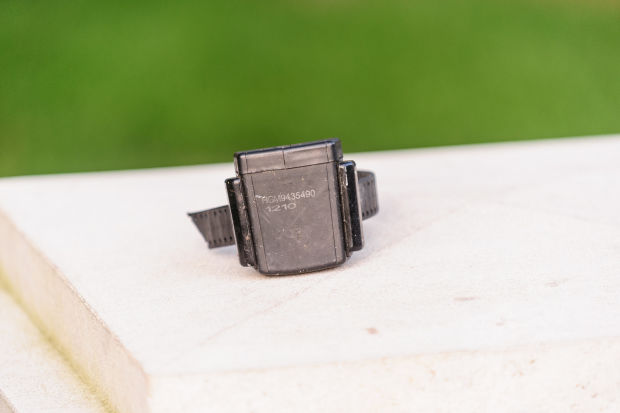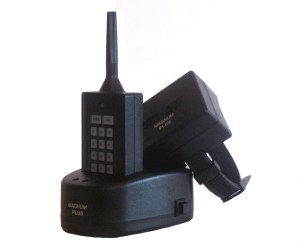Cook County runs the largest electronic monitoring program in the country. On a given day some 2,200 are on some form of monitor as a condition of pre-trial release. Cook County’s program has at least three positive features that are not present in most jurisdictions. First, they use only Radio Frequency (RF), not GPS. An RF device does not track your every move but merely indicates whether the person being monitored is at home or not. Second, the recommendation of the Sheriff’s office is that people get credit for time served when they are awaiting trial under house arrest. At least this is a recognition that EM is not a mere condition of release (like not allowing alcohol or avoiding “drug areas”) but that electronic monitoring is a form of incarceration-part of what some folks are now calling E-carceration. Third, unlike in many places, those on EM in Cook County don’t have to pay daily user fees.
Yet despite these pluses, many people on EM in Cook County still experience the usual difficulties. This article from Injustice Watch describes some of the challenges people on EM face in getting movement out of the house and in going about their daily business.
 Every evening in the bowels of the Cook County Criminal Court complex, men and women whom bond court judges have released under electronic house arrest assemble under the watchful eyes of sheriff’s deputies in a cage-like grey and cream-colored processing area.
Every evening in the bowels of the Cook County Criminal Court complex, men and women whom bond court judges have released under electronic house arrest assemble under the watchful eyes of sheriff’s deputies in a cage-like grey and cream-colored processing area.
This is the last stop in a journey that began with an arrest. Each has spent a night or longer in the county jail or a police lockup, had a brief interview by a pretrial social worker, met with an assistant public defender, and appeared for 60 to 90 seconds before a bond court judge. Those steps complete, they now are preparing to head home.
On screens in the background, a video explaining the rules and regulations of their technology-restricted freedom plays on a continuous loop.
Black ankle bracelets about the size of cigarette packages soon will be attached to their ankles. The devices will constantly monitor them and alert the Cook County Sheriff’s Office if they leave their homes for more than a few minutes.
Then they will be driven to their homes, where deputies will install cell-phone-connected monitoring devices.
None of these men and women have been convicted of crimes but they are, for the most part, sentenced to house arrest by what one lawyer called an “electronic ball and chain.”
In Cook County and across the country, increasing pressure is mounting to reform the longstanding system of holding most defendants charged with crimes in custody unless and until they can post cash bail. The push is fueled both by pressure to reduce the number of persons held in jail awaiting trial, and by lawsuits contending that holding persons in custody because they are too poor to post bail is unconstitutional.
An Injustice Watch examination of the bail system in October found that efforts by Cook County officials to release more pretrial defendants have faced a number of obstacles. The jail is filled with thousands of men and women each day who have not been convicted of anything but remain locked up because they cannot post the required bond, regardless of whether they pose any danger.
In recent months, judges have been releasing more defendants without requiring cash bail, sending them home to await trial. As the number increases, in many cases judges are requiring defendants to wear electronic monitoring equipment as an alternative to jail.
Observing weeks of bond courts throughout Cook County this summer, Injustice Watch journalists found that 21 percent of defendants appearing in bond court were released and monitored electronically, sometimes also required to post a bond. (The sheriff uses a slightly higher percentage.)
Each day in Cook County, some 2,200 pretrial defendants are monitored by the sheriff while they are on electronic monitoring. As many as 500 others are monitored under a much smaller curfew program, operated by the court’s pretrial services division, that requires them to be in their homes between 7 p.m. and 7 a.m.
Monitored defendants wear devices for a few days or for a year or more while awaiting a trial. The median number of days is 19.
The increase in electronic monitoring mirrors what is happening around the country.
Nationwide, electronic monitoring has grown 140 percent in the last decade. Some form of technological monitoring for both pretrial defendants and convicted offenders is used in all 50 states. Fueled by the introduction of GPS-based monitoring systems, electronic monitoring has expanded from approximately 53,000 deployed devices in 2005 to an estimated 131,000 units in 2015.
On a single day in 2015, corrections departments nationwide used electronic devices to track the movements of 125,000 persons in the criminal justice system, a PEW study found. Other researchers believe that number is now even larger.
Many advocates of bail reform caution that judges are overusing electronic monitoring for persons who committed nonviolent crimes and pose no threat to the public or danger of fleeing.
“A reasonable percentage of the people that the judges put on [electronic monitoring] really didn’t need it, or their need for it could vary,” said William Bales, director of Florida State University’s Center for Criminology and Public Policy in a PEW Charitable Trust discussion on the advantages and disadvantages of electronic monitoring technologies.
Cook County commissioners fund the costs of both the court’s and the sheriff’s electronic monitoring. The current $13.75 million three-year electronic monitoring contract was amended twice without debate by the Cook County Board, increasing by more than 58 percent since 2013. It expires next February.
The sheriff uses an electronic monitoring system provided by 3M, the company that makes Post-it notes and Scotch tape. 3M is one of 11 companies nationwide that sell or lease equipment to courts, corrections departments, and sheriffs.
The Cook County contract calls for cellphone-based radio frequency (RF) monitors that rely on a transmitter connected in each defendant’s home. The monitors send alerts when a defendant leaves home or cuts the bracelet. The device includes a button defendants can use to answer a call from the sheriff — a way of making certain they are where they should be. There is also a button they can use to signal an emergency.
The county’s electronic monitoring system cannot work for defendants with no home besides the streets.
Each day, dozens of people whom judges approved for electronic monitoring instead remain locked up because there is no suitable place to house them outside of custody. Some are accused of crimes like domestic violence and are under orders not to be in their own homes. Others are homeless, and the sheriff’s office struggles to find beds in shelters for them by both contracting with shelters and providing telephones so those in need can try to find temporary housing on their own.
On Thursday, the sheriff had managed to place 132 people awaiting trial – 102 men and 30 women – in shelters. Another 142 defendants – 131 men and 11 women – remained locked up because there was no suitable place for them to stay.
In many jurisdictions across the country, the radio frequency systems are being replaced with newer, more flexible GPS-based electronic monitoring devices.
“Electronic monitoring is still pretrial detention — restricting the liberty of people who haven’t been convicted of anything,” said Sharlyn Grace, a policy fellow at the Chicago Appleseed Fund for Justice. “Electronic monitoring is just a way the criminal justice system has expanded. It is another form of pretrial punishment.”
Defendants nevertheless generally find it an easy decision to choose electronic confinement at home over waiting for trial behind the institutional walls of Cook County Jail.
“This place is noisy all night, people don’t leave you alone and the food stinks,” said Meagan F., who was arrested for retail theft and drug possession in September and is home wearing a monitoring bracelet and awaiting an evaluation for drug treatment. “Hell yeah, I’d rather be at home than here, but I got to call [to get permission] for movement. How do I get groceries or do my laundry?”
“I don’t really like it, but anything is better than being locked up in this place,” said Marquis W., who was arrested for drug possession and riding his bicycle on the sidewalk and whose charges were dismissed less than a month later after a period of electronically monitored house arrest.
Before leaving the county jail, pretrial defendants receive warnings not to violate the terms of their monitored release or face possible prosecution for escape. But once home, they may find the system is difficult and more limiting than they expected, defense lawyers say.
The sheriff requires that defendants on electronic monitoring win judicial approval if they wish to attend classes, work, attend to family matters like taking a child to and from school, or going to medical appointments. Otherwise, defendants are not permitted to leave the house.
“It is restrictive in ways that I don’t think people foresee,” said Chicago criminal defense attorney Lillian M. McCartin. “It is based on the concept that you have to have someone take care of you. You can’t get movement to go grocery shopping or go out if you want to take your kids to school. It is a constant battle.”
A Cook County Board committee on Thursday heard testimony from a man identified as Tyler Smith, 21, who described first being kept in custody and then released on electronic monitoring. Being put on electronic monitoring, Smith told the committee, “is nothing different from being incarcerated in jail. When you’re on home confinement, it’s like a prison. You have for to ask permission to leave your home to even to go to a grocery store.”
Danita Ivory, an assistant Cook County public defender, said that the restrictions can sometimes leave clients without permission to go to work even if they have verification from an employer. Clients call the office because the sheriff insists they need a court order to attend work, though some judges say they will not sign the order because the sheriff should not need them to, Ivory said.
“Sometimes the judges and the sheriff throw it back on each other and our clients get caught in the middle,” said Ivory, who supervises felony trials.
“We get calls saying the sheriff is not letting them go to work without a court order … and there are some judges who take the position the sheriff can do whatever they want and … they are not going to sign a specific order,” she added. “The client unfortunately is caught in the middle.”
The sheriff’s office contends that it has no choice. Once a defendant is placed on a monitoring program 24 hours a day, only a judge can revise the order to permit them to go outside, even to attend work, school, or pick up children, according to Cara Smith, the chief policy officer for Sheriff Tom Dart. She said her office works with judges to effect appropriate revisions.
“Every case involves at least three different judges. There is the bond court judge, the preliminary hearing judge, and the trial judge,” Smith explained. “There is a lot of ‘not my job’ when trying to get bond [and electronic monitoring] conditions reviewed.
“Often a judge [in the process] will say, ‘I’m not going to upset a decision made by one of my colleagues,’” she continued. “The structure of our system is very unforgiving in terms of seeking adjustments or changes in bond [and electronic monitoring] decisions.”
As a result, defendants often find themselves caught in a legal no-man’s land with the sheriff on one side and the courts on the other.
Smith said the sheriff and Cook County Public Defender Amy Campanelli have worked to “streamline” the movement issue.
“I think [defense lawyers’] frustration is with electronic monitoring, period,” Smith said. “They would prefer their clients have complete freedom pretrial, and that is a gripe you have with the judges.”
In Washington, D.C., judges strive to limit the use of electronic monitoring even as the court system has moved away from requiring cash bail for release. “I know that in many places, electronic monitoring is a kind of panacea of a standard condition thrown on people who are being released,” said Judge Truman Morrison of the D.C. Superior Court. “We have historically tried to limit electronic monitoring to where it is really needed [such as] in domestic violence cases. … We use it in a very limited fashion.”
Even so, Washington officials have found that defendants tend to appear for their court dates regardless of electronic monitoring.
Ali Abid, an Appleseed Foundation fellow who has been studying bail practices, is among those urging Cook County to be more flexible in the conditions imposed on persons upon arrest.
“Electronic monitoring is an easy stepping stone” as judges move away from routinely requiring cash bond, Abid says, but the “electronic monitoring system is not very nimble.”
 The Illinois state assembly’s judiciary committee is currently considering a radical bill on electronic monitoring. The submission, HB 3887, sponsored by State Rep. Carol Ammons of Urbana, would ban daily user fees for electronic monitoring, provide credit for time served for all those on a monitor while awaiting trial, and guarantee a minimum of 8 hours of movement out of the house for anyone on a monitor.
The Illinois state assembly’s judiciary committee is currently considering a radical bill on electronic monitoring. The submission, HB 3887, sponsored by State Rep. Carol Ammons of Urbana, would ban daily user fees for electronic monitoring, provide credit for time served for all those on a monitor while awaiting trial, and guarantee a minimum of 8 hours of movement out of the house for anyone on a monitor. Every evening in the bowels of the Cook County Criminal Court complex, men and women whom bond court judges have released under electronic house arrest assemble under the watchful eyes of sheriff’s deputies in a cage-like grey and cream-colored processing area.
Every evening in the bowels of the Cook County Criminal Court complex, men and women whom bond court judges have released under electronic house arrest assemble under the watchful eyes of sheriff’s deputies in a cage-like grey and cream-colored processing area.

 In recent months, authorities in at least two countries, Germany and Israel, have suggested putting electronic monitors on people with ties to or a history of involvement with “terrorist” groups. While at the moment this is targeted at a narrow circle of people, this effectively opens the door to discussion of monitoring a range of people viewed as “political dissidents,” “subversives”, “revolutionaries”, “militants,” etc. In the light of the recent upsurges in political activity in the US, especially the mobilizations among people of color around issues of police violence and immigrant rights, there is cause for concern.
In recent months, authorities in at least two countries, Germany and Israel, have suggested putting electronic monitors on people with ties to or a history of involvement with “terrorist” groups. While at the moment this is targeted at a narrow circle of people, this effectively opens the door to discussion of monitoring a range of people viewed as “political dissidents,” “subversives”, “revolutionaries”, “militants,” etc. In the light of the recent upsurges in political activity in the US, especially the mobilizations among people of color around issues of police violence and immigrant rights, there is cause for concern.


